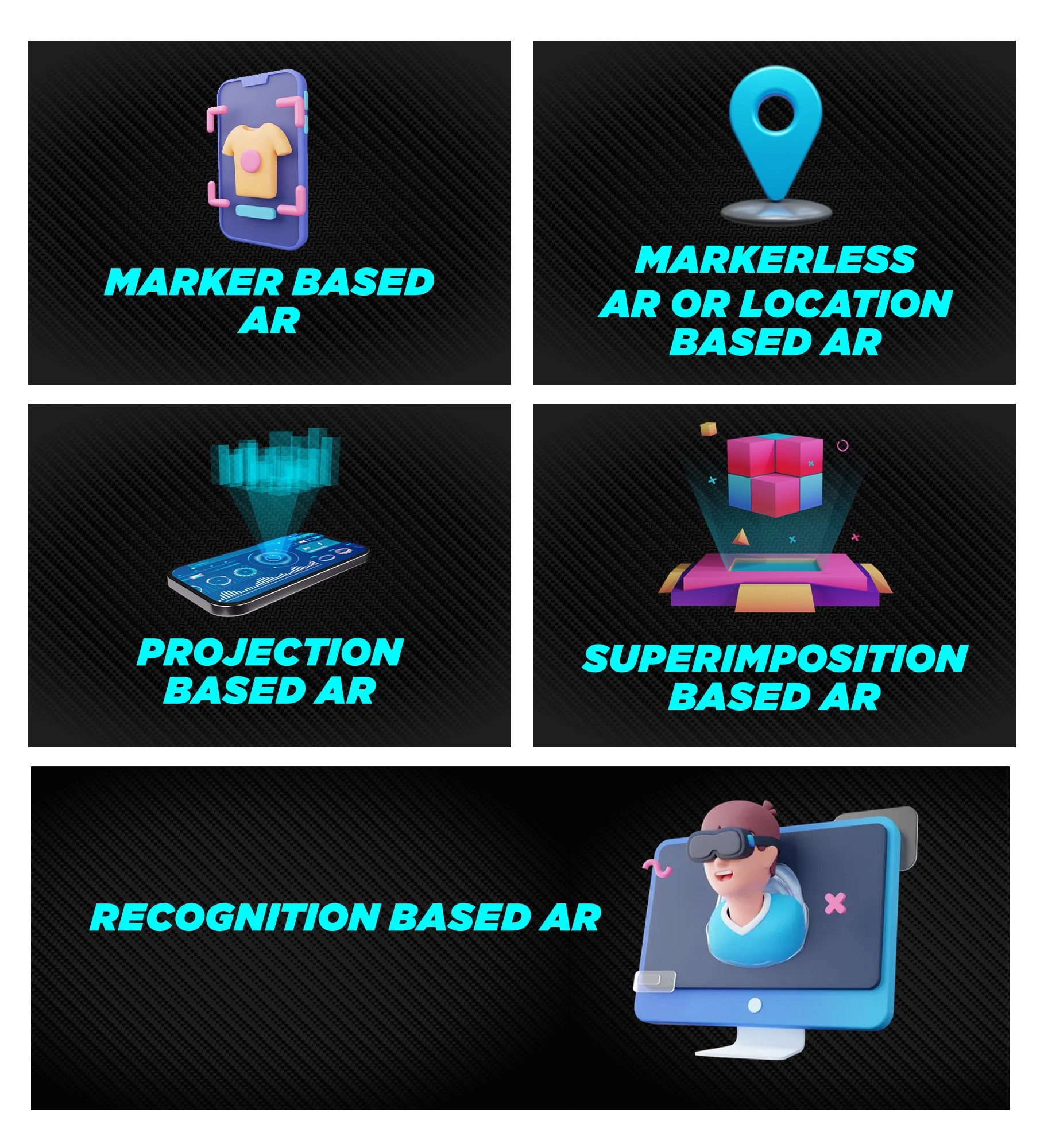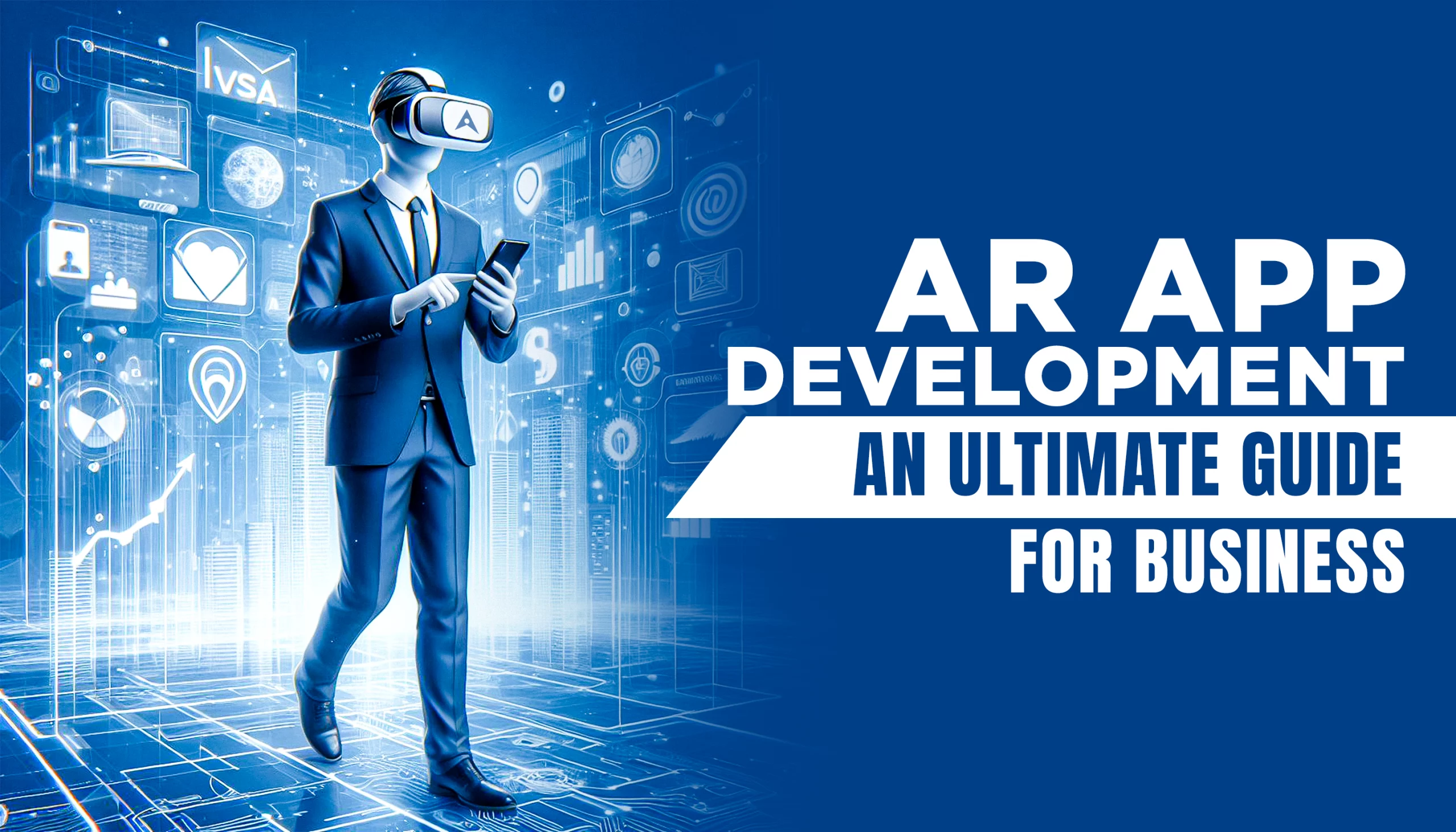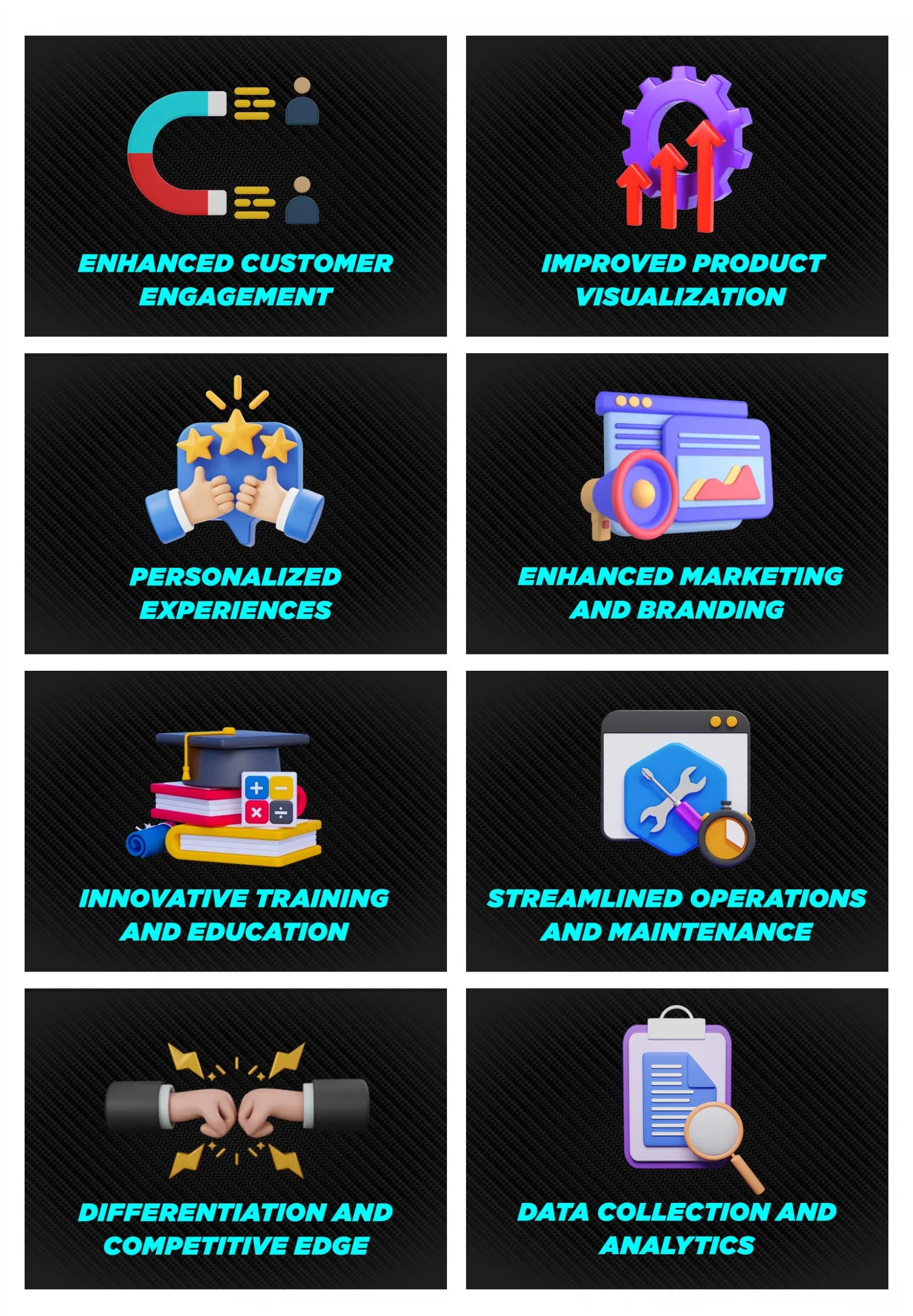Imagine a bustling city, where augmented reality (AR) is not just a technology—it’s a way of life.
A fascinating world where AR glasses and devices digitally paint the urban landscape with interactive murals and immersive experiences. Artists create digital masterpieces in cafes, while children chase virtual creatures in parks.
Customers, wearing AR headsets, engage in immersive book readings, where characters jump from pages and wander the cafe’s floors. In office spaces, professionals collaborate in virtual boardrooms projected through AR goggles and brainstorm ideas while manipulating 3D holographic displays. Architects and designers use AR tools to visualize and tweak blueprints and transform empty spaces into digital prototypes.
Amidst all this, entrepreneurs craft innovative AR apps, pushing the boundaries of creativity and functionality. These augmented reality apps enhance the capability of mobile apps and smartphones in incredible ways.
In this city, AR intertwines reality and human imagination seamlessly with daily life and fosters wonder at every turn.
Would you like to experience such a place?
Well, this city may sound fictional at the moment. But the way augmented reality technology is transforming our lives and business activities, you might witness such a world in the near future. At least with AR apps.
Today, augmented reality apps have become one of the top trends in mobile app development field. Both consumers and businesses like to use apps enriched with AR features. Whether it is ecommerce, healthcare, retail, gaming, or education, every market segment is increasingly leveraging the advantages of AR in apps for various purposes.
According to the latest industry reports, the global mobile augmented reality (AR) market size is projected to reach $184.61 Billion by 2030 at a whopping CAGR of 31.40%. By the completion of 2023, there would be 1.4 Billion AR device users.
So, with this growing market and rapid consumer adoption, AR app development offers great lucrative scope for businesses. By developing augmented reality apps startups and enterprises can not only enhance performance but also improve user experience.
If you are also planning to enter this market and build an AR app for your business, here is an ultimate guide for your help. In this guide, you will learn everything about AR app development and other important things to successfully launch your augmented reality mobile app.
So, why wait then? Let’s dive into
Table of Contents
What Is Augmented Reality App Development?
Augmented reality (AR) app development is the process of creating augmented reality applications or software. These AR apps overlay digital information or virtual objects onto the real world through a camera or screen. It’s the method of designing, building, and implementing techniques that blend computer-generated content with the user’s physical environment in real-time. AR apps make this interaction possible by using the device’s camera and sensors to recognize and interpret the environment.
What Are The Types Of Augmented Reality Apps?
 There are different types of AR apps that use various methods to blend the real-world environment with digital elements. Based on the use case and technology used, each app type follows its own way to add digital stuff to the real world through your device and offer a unique and engaging experience. Below, we have shared the types of AR apps that are widely used across all business domains and industries.
There are different types of AR apps that use various methods to blend the real-world environment with digital elements. Based on the use case and technology used, each app type follows its own way to add digital stuff to the real world through your device and offer a unique and engaging experience. Below, we have shared the types of AR apps that are widely used across all business domains and industries.
Marker-based AR: These apps use markers, like QR codes or specific images, as triggers. When the device’s camera recognizes these markers, it overlays digital content linked to them. For example, pointing your device at a specific logo might trigger a 3D animation or information display related to that logo.
Markerless AR or Location-based AR: These apps don’t need markers. Instead, they use GPS, compass, or other location-tracking technologies to place virtual content in specific real-world locations. Think of apps that show you nearby places or guide you with information as you move around.
Projection-based AR: This type projects digital content onto real-world surfaces. For instance, it might project a keyboard onto a table, allowing you to type as if it’s a physical keyboard.
Recognition-based AR: These apps recognize specific objects or patterns and overlay information or content related to them. For instance, an app might recognize a plant and provide information about it when you point your camera at it.
Superimposition-based AR: These apps replace or add digital elements directly onto what your device’s camera sees. They can change how things look without needing markers or specific locations. Filters in social media apps, for instance, are a type of superimposition-based AR, adding masks or effects to your face in real time.
Key Components Of AR App Development
AR app development contains various key components. These components work together to smoothly blend digital content with what you see through your device and give users fun and useful experiences. When developing an augmented reality (AR) app, there are some important parts that help it work smoothly:
AR Development Tools: These are special software and kits that AR or VR app developers use to create AR experiences. They help access your device’s features like the camera, sensors, and more, making it possible to add digital things into the real world.
3D Modeling and Rendering: Creating digital objects in three dimensions (3D) is like making virtual sculptures. These objects need to look good and fit perfectly into the real world when you see them through your device.
Integration with Real-world Elements: AR apps need to recognize and interact with real things around you. This means making sure that the digital stuff fits well with what your device’s camera sees. Thus, it feels like they’re actually there.
User Interface (UI) and User Experience (UX): Designing how users interact with digital content is crucial. This involves making it easy and natural for you to use the app, so it feels like the digital stuff is part of your real surroundings.
Advantages Of AR Apps: Why Businesses Should Invest In AR App Development?
Augmented reality mobile apps offer a broad range of benefits for both consumers and business owners. With AR mobile apps, users get plenty of innovative features and indulge in immersive mobile experience. Therefore, businesses today find AR app development one of the highly profitable domains. If you look at the current augmented reality market and mobile app industry statistics, you will find a surge in the demand for augmented reality development services.
- Conversion rates are recorded 40% higher with augmented reality.
- 70% of consumers believe AR has the potential to support skill development.
- By the end of 2023, it is projected there will be 1.4 Billion AR device users.
- The mobile AR revenue is estimated to grow from $12.45 Billion in 2021 to $21.03 by 2023.
- 41% is the growth rate of the global AR market. (Source: G2)
This massive growth in the AR market is due to the benefits that augmented reality technology offers. These advantages have demonstrated how AR apps can boost engagement and make the user experience more personalized. As a result, it helps businesses stand out in a competitive market. The below reasons compel businesses to invest in AR VR development services.
1. Enhanced Customer Engagement
AR VR apps have better capability to grab people’s attention. It allows them to interact with digital content in the real world. Instead of just watching or reading about something, users can actively participate. This engagement is like playing a fun game or trying on virtual clothes. Thus, it makes the experience more exciting and memorable.
2. Improved Product Visualization
Imagine being able to see how a piece of furniture would look in your room before buying it. If you have ever used the IKEA Place app, you must have experienced how AR apps can help you visualize products in your own space. This app lets you see how they fit or match with your surroundings. Consequently, you can make better decisions about what to buy.
3. Personalized Experiences
Augmented reality apps can adapt to your interests and preferences. For example, if you’re using an AR shopping app, it might show recommendations based on your past choices or style. This personalized touch makes the experience feel tailor-made just for you.
4. Enhanced Marketing and Branding
Businesses use AR to create cool and memorable experiences for customers. Think about interactive ads or games related to a product. These experiences stick in your mind. And thus, making you more likely to remember and choose that brand or product later.
5. Innovative Training and Education
AR apps make learning more fun and hands-on. For instance, imagine an app that teaches you how to fix something by showing step-by-step instructions on the actual object through your device. It’s like having a helpful guide right in front of you.
6. Streamlined Operations and Maintenance
In industries such as manufacturing or maintenance, AR apps can guide workers through tasks. For instance, engineers fixing machinery might use augmented reality apps to see instructions or diagrams overlaid on the equipment. Hence, it can make their job easier and faster.
7. Differentiation and Competitive Edge
Businesses that use AR early on stand out from others. By offering innovative and unique experiences, they catch people’s attention. And thus they can better attract more customers who are interested in trying new things.
8. Data Collection and Analytics
AR apps collect information on how users interact with them. This data helps businesses understand what users like, what they don’t, and what they’re interested in. By analyzing this data, businesses can improve their products or services and make better marketing decisions.
Major Applications or Use Cases Of AR Apps In Different Industries
AR technology is for all industries and businesses. It is not only meant for gaming or entertainment but also for education, sales, and marketing. No matter what industry your business serves AR app development is transforming industries by streamlining providing engaging, interactive, and practical solutions. Here are some of the major applications or use cases of AR apps for different industries.
AR Apps for Retail and E-Commerce
Augmented reality apps let customers virtually try on clothes, accessories, or even makeup before buying online. Ecommerce and retail businesses can use AR apps to let their customers virtually visualize how their products see. For example, customers can see how furniture, home decor, or other items would look in their homes before purchasing.
AR Apps for Gaming and Entertainment
Immersive gaming is one of the top emerging trends in augmented and virtual reality mobile app development. AR games merge digital elements with the real world, encouraging users to interact with virtual characters or scenarios in their surroundings. These apps also offer interactive content like storytelling or art installations. As a result, it enhances engagement.
AR Apps for Education and Training
AR mobile apps enhance elearning experience by offering interactive lessons. It allows students to visualize complex subjects like anatomy or astronomy in 3D. Several industries use AR and AI in elearning for hands-on training, such as simulations for medical procedures or machinery operations.
AR Apps for Healthcare
These apps assist medical professionals in training by providing 3D models for surgical procedures or patient anatomy visualization. In patient care, it helps improve patient experiences by displaying vital information, aiding in diagnostics, or guiding surgeries.
AR Apps for Manufacturing and Maintenance
Augmented reality technology works as a highly effective tool for the manufacturing sector. With augmented reality apps, companies guide workers in assembling or repairing machinery. These apps improve employee training by overlaying step-by-step instructions or highlighting components. Technicians use AR to receive real-time guidance from experts. As a result, this improves efficiency in maintenance tasks.
AR Apps for Real Estate
In the real estate app development, AR is used for property Visualization. AR helps potential buyers visualize properties. And thus, allowing them to see virtual furniture or renovations within a property. Besides this, architects and construction professionals use AR to visualize designs at construction sites. Consequently, this aids in smart planning and decision-making.
AR Apps for Travel and Tourism
Augmented reality is reshaping the travel & tourism industry. Travel agencies and companies now add AR features in their apps and provide immersive and interactive travel experience. Through AR-powered travel apps, users get access to interactive guides or tours at historical sites, museums, or tourist attractions. Which, as a result, enhances the visitor experience. In addition to this, AR-based translation apps also assist travelers by translating signs or text in real time through their devices.
How to Develop An AR App: Step-by-Step AR App Development Process
AR app development is the process of using tools & SDKs to create mobile apps with augmented reality features. It’s like building virtual objects that can appear on your screen and act like they’re really there when you look through your device.
This process involves planning what the app will do, designing how it’ll look, and then making it work using code. Developers use 3D modeling to create these digital objects and figure out how they fit into the real world when someone uses the app.
Hence, AR app development aims to make these apps fun, useful, or helpful in some way. As a business owner, you must ensure maximum resource utilization. So, here is the below step-by-step process that would help you to build an AR app successfully.
1. Conduct In-Depth Market Research
Having detailed information related to your project is the foremost thing. You need to aware of everything about your app and business goals. Therefore, first, you need to conduct market research and collect data insights. This will help you understand various important things such as
- Who is your target audience?
- Which problems will your AR app solve?
- What unique features are there in your app?
- Are there any similar apps already in the market?
2. Define Your AR App Concept
Once you have all the essential information you can clearly outline what your app will do and who it’s for. Think about the problem it solves or the experience it provides. This step helps you set a clear direction for your AR app development. Defining an app concept is a part of product discovery. Therefore, you should consider getting help from experts to find top mobile app ideas for AR solutions.
3. Decide the Key Features of AR Mobile App
This is one of the important steps in the AR software development process. You need to identify the essential functionalities your app will offer. For an AR app, this might include features like object recognition, 3D visualization, or interactive elements. Listing these features could help you prioritize what’s crucial for your app’s success. Hence, to give an overview, here are the most common or key features of augmented reality apps.
- Image Recognition
- Object Recognition and Tracking
- Surface Detection
- Location-based AR
- 3D Modeling and Rendering
- Motion Tracking
- Interactive Elements
- Real-time Rendering and Processing
- Social Sharing and Collaboration
- Integration with Hardware Features
- Customization and Personalization
- Offline Functionality
4. Choose Tech Stack for AR App Development
Select the tools, frameworks, and programming languages needed to build your app. For AR, this could involve picking specific AR development kits (like ARKit or ARCore) and deciding on the platforms you’ll develop for (iOS, Android, etc.). However, the selection of tools, augmented reality SDKs, and frameworks depends on your specific project requirements. Therefore, you should consult an expert AR app development company or hire dedicated app developers for this. Below we have shared the tech stack for AR app development.
| Layer | Technology |
| Hardware | Smartphones, Tablets |
| Operating System | iOS, Android |
| AR Development Kits | ARKit (iOS), ARCore (Android) |
| Programming Languages | Swift (iOS), Java/Kotlin (Android) |
| 3D Modeling & Rendering | Unity, Unreal Engine |
| Tracking & Recognition | Vuforia, Wikitude, ARToolKit |
| Cloud Services | AWS, Azure, Google Cloud Platform |
| Integrated Development Environment (IDE) | Xcode (iOS), Android Studio (Android) |
| Version Control | Git, SVN |
| APIs | OpenGL, WebGL |
5. Create a Prototype
In the first phase of AR app development, you need to build a simple version of your app to test its basic functionalities and user experience. This prototype helps visualize how your app will work. It allows for early feedback from potential users so that you can make the required changes before the official app launch.
6. Start Development
This is where the actual coding happens. Your augmented reality app developers will start writing code. They will now build the features and all other functionalities to bring your app to life based on the features and design you’ve outlined. They will use the chosen technology stack and AR tools to integrate augmented reality elements into the app.
7. Conduct Comprehensive Testing & QA
After the development, test your app thoroughly to find and fix any bugs or issues. Check how the AR features work on different devices and in various conditions. This quality assurance ensures your app runs smoothly and provides a good user experience.
8. Launch & Monitor
Once your app is tested and polished, launch it in the app stores. After launch, you need to monitor its performance by collecting user feedback, analyzing app metrics, and addressing any issues that arise post-launch. Keep a watch on user feedback and reviews. If there is a need for any update or improvement in your app, you can modify your app accordingly.
How Much Does It Cost To Develop An AR App?
On average, AR app development cost can go between $15,000-$30,000 for a small-scale application. However, the cost to build an AR app involves several factors. It includes the app size, complexity, number of features, use of AR SDK, etc. If your app incorporates advanced AR/VR solutions then it will take more time and resources to build it. As a result, the final cost of augmented reality app development will also increase. Therefore, the best way to get the right estimation of how much does it cost to develop an AR app is to consult a professional AR VR app development company. They will provide the exact cost value based on particular project needs.
Challenges in Developing AR Apps
Hardware Limitations
Different devices have varying capabilities. You will have to ensure that your AR app works smoothly across various smartphones or tablets can be tricky. Some devices might struggle with processing power or lack certain sensors necessary for robust AR experiences. Thus, it can be a challenge to ensure seamless interconnection.
AR Tracking and Calibration
Your AR app developers will have to make virtual objects that interact with the real world accurately. You have to make sure that AR elements stay in the right place. Also, it should align correctly with the environment. Hence, it requires precise tracking and calibration, which can be complex to achieve.
User Interface and Experience
Creating a seamless and intuitive user interface in augmented reality apps can be tough. Your augmented and virtual reality app developers have to design interactions that feel natural. Your app should allow users to effectively use AR features without overwhelming. So, to make them requires careful planning and testing.
3D AR Content Creation and Optimization
Developing high-quality 3D models or AR content that looks realistic and integrates well into the real world involves significant effort. Your augmented reality app development company
has to optimize these assets to work efficiently on different devices without compromising quality. Hence, it adds another layer of complexity.
Performance and Battery Drain
AR apps demand significant processing power and can drain device batteries quickly. As a result, balancing high-performance visuals with optimal battery usage becomes a challenge. As users expect smooth experiences without sacrificing battery life, your AR app must support longer battery life.
Compatibility and Fragmentation
With a wide range of device models, operating systems, and versions in the market, ensuring that your AR app works consistently across these platforms can be challenging. You have to eliminate all kinds of issues related to compatibility and fragmentation. This process is a difficult task.
Data Privacy and Security
AR apps often collect user data or use location-based features. Hence, you will need to ensure user privacy and security of this data. Especially when dealing with real-time camera usage or location tracking, it is critical and can pose regulatory and ethical challenges.
Top Examples Of Businesses That Succeeded with AR Apps
There are many examples that demonstrate how various businesses and industries, from retail to gaming and automotive, have successfully utilized AR apps to engage users and offer personalized experiences. And thus they improved sales growth by driving better customer interaction and satisfaction through AR app development.
IKEA Place: IKEA’s AR app allows customers to virtually place furniture in their homes using their smartphones. It enables users to see how IKEA products would look and fit in their living spaces before making a purchase. Consequently, it boosts confidence and reduces return rate.
Pokemon GO: Developed by Niantic, this game took the world by storm by combining AR technology with the beloved Pokémon franchise. Players explore the real world to find and capture virtual Pokémon. For this, the app leverages location-based AR to create an immersive gaming experience.
Sephora Virtual Artist: Sephora’s AR app lets users try on makeup virtually. Customers can test different shades of lipstick, eyeshadow, and other cosmetics using their phone’s camera. Thus, the app offers a more interactive and personalized shopping experience.
L’Oréal’s Style My Hair: This app allows users to try various hair colors and styles virtually. By leveraging AR, users can visualize how different hair colors would look on them before committing to a change. It helps buyers improve their decision-making process.
Mercedes-Benz AR Owner’s Manual: Mercedes-Benz introduced an AR app that provides vehicle owners with an interactive and immersive experience of their car’s functionalities. Users can explore and understand various features through their smartphone or tablet.
Wayfair’s AR View: Similar to IKEA Place, Wayfair’s AR app enables users to visualize furniture and décor items in their homes. Customers can virtually place products and assess their suitability in their living spaces before making a purchase.
Concluding Thoughts
Augmented reality is a powerful and innovative technology. It has transformative potential to streamline business operations and redefine user experience. By integrating augmented reality features in mobile apps, businesses can not only solve ongoing problems effectively but also improve sales growth by engaging customers with immersive experiences. Today, consumers are highly interested in using AR-powered apps and devices.
From Google to IKEA, all business sizes are leveraging the power of this technology. Therefore, the use of AR in mobile app development is set to reach new heights. However, since integrating augmented reality in mobile apps requires expertise and great research, it is better to seek consultation from an experienced AR VR app development company that provides the best augmented reality app development services.












 India
India USA
USA Australia
Australia Canada
Canada UK
UK UAE
UAE